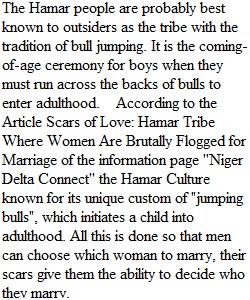


Q Rationale Before going into the field, anthropologists do background research to see what is already known about the group or topic that they are studying. For your ethnography, you will supplement your personal research with published research. Locate three sources about the Hamar culture. One of those must be a credible academic source (e.g. professional journal article, book, encyclopedia, or website ending in .org, .edu, or .gov) about the Hamar. Do NOT use Wikipedia, as it is not a reliable source. Use the SLCC Markosian Library website as a starting point for your academic source and search for anthropology, sociology, or psychology papers that discuss the Hamar. Remember, you are trying to find at least one source about the culture of the Hamar, not just their history, so try search terms like "Hamar anthropology" or "Hamar culture". If you are not sure if your sources are appropriate, or if you are having difficulty finding academic sources that address your specific ethnographic group, please contact me for help. Instructions In a 1-2 page Chicago Style paper with a title page, summarize the information from each of the three sources you find. Include a short introduction paragraph, one summary paragraph for each source, and a short conclusion. A summary covers all the key points of the article, and lays out the author's arguments and conclusions. Be sure to include in-text citations in your summary paragraphs for both direct quotes and summarized/paraphrased material, and provide a complete Chicago Style reference for each source on a separate References page at the end of your paper. Review the Writing in Chicago Style page for help with in-text citations, references, and formatting. You can also take a look at a former student's paper Actions as an example. Objectives The goals of this assignment are to meet student learning objectives including: • Understanding of the cultural diversity found throughout the world; • Identifying ethnocentrism and communicating effectively about diverse cultural practices from a cultural relativity perspective; • Understanding the methods used by cultural anthropologists. Rubric Ethnographic Literature Search rubric Ethnographic Literature Search rubric Criteria Ratings Pts This criterion is linked to a Learning OutcomeChicago Style Used to assess whether your assignment follows all of the requirements of Chicago Style 5 pts Full Marks Paper includes a Chicago Style title page, Chicago Style formatting throughout, and all necessary in-text citations and references 4 pts Minor issues Paper has minor issues with Chicago Style,such as the title page, overall page formatting, or formatting of in-text citations or references 3 pts Moderate Issues Paper has moderate issues with Chicago Style formatting, such as incorrect use of in-text citations, incomplete references, or larger issues with overall page formatting. 2 pts Major Issues Paper has serious issues with Chicago Style formatting, such as a missing title page, or serious issues with properly citing and referencing sources 0 pts No Marks Paper does not follow any aspects of Chicago Style and is missing a title page, proper formatting, and any necessary citations or references 5 pts This criterion is linked to a Learning OutcomeFirst Source Used to assess whether a chosen source is reliable and acceptible 5 pts Full Marks Source was published by a credible or academic author and provides information that is likely to relate directly to an understanding of the ethnographic group that will be studied. 3 pts Partial Credit Source is not from a credible author, or the information is unlikely to contribute much to the understanding of the ethnographic group that will be studied. 0 pts No Marks Source is missing or does not relate to the ethnographic group being studied. 5 pts This criterion is linked to a Learning OutcomeSecond Source Used to assess whether a chosen source is reliable and acceptible 5 pts Full Marks Source was published by a credible or academic author and provides information that is likely to relate directly to an understanding of the ethnographic group that will be studied. 3 pts Partial Credit Source is not from a credible author, or the information is unlikely to contribute much to the understanding of the ethnographic group that will be studied. 0 pts No Marks Source is missing or does not relate to the ethnographic group being studied. 5 pts This criterion is linked to a Learning OutcomeThird Source Used to assess whether a chosen source is reliable and acceptible 5 pts Full Marks Source was published by a credible or academic author and provides information that is likely to relate directly to an understanding of the ethnographic group that will be studied. 3 pts Partial Credit Source is not from a credible author, or the information is unlikely to contribute much to the understanding of the ethnographic group that will be studied. 0 pts No Marks Source is missing or does not relate to the ethnographic group being studied. 5 pts This criterion is linked to a Learning OutcomeSource Summaries Used to assess your ability to summarize the key points and conclusions from your literature search sources 10 pts Full Marks Each article is described in detail, so that the reader can understand the main points and conclusion of the article, and how all three articles relate to an understanding of the ethnographic group that will be studied. 6 pts Partial Credit Each article is described, but there is insufficient detail regarding the main points and conclusion of the articles, or it is difficult to understand how these points will assist in understanding of the ethnographic group to be studied 3 pts Does Not Meet Expectations Not all articles are described, or they are described with minimal detail. 0 pts No Marks The three literature search articles have not been summarized. 10 pts Total Points: 30 PreviousNext
View Related Questions